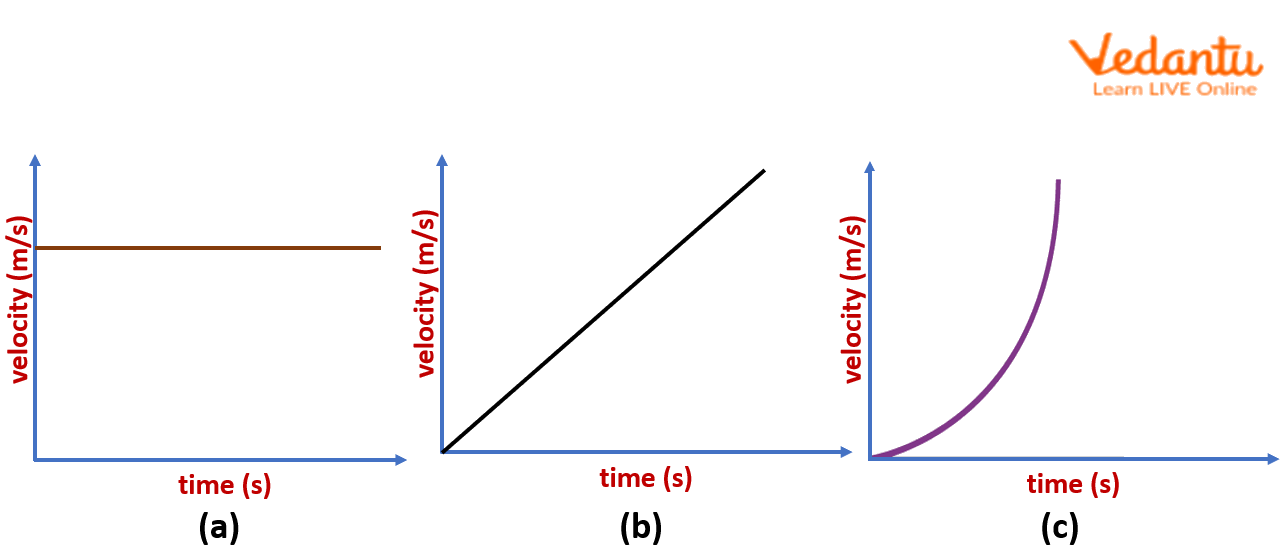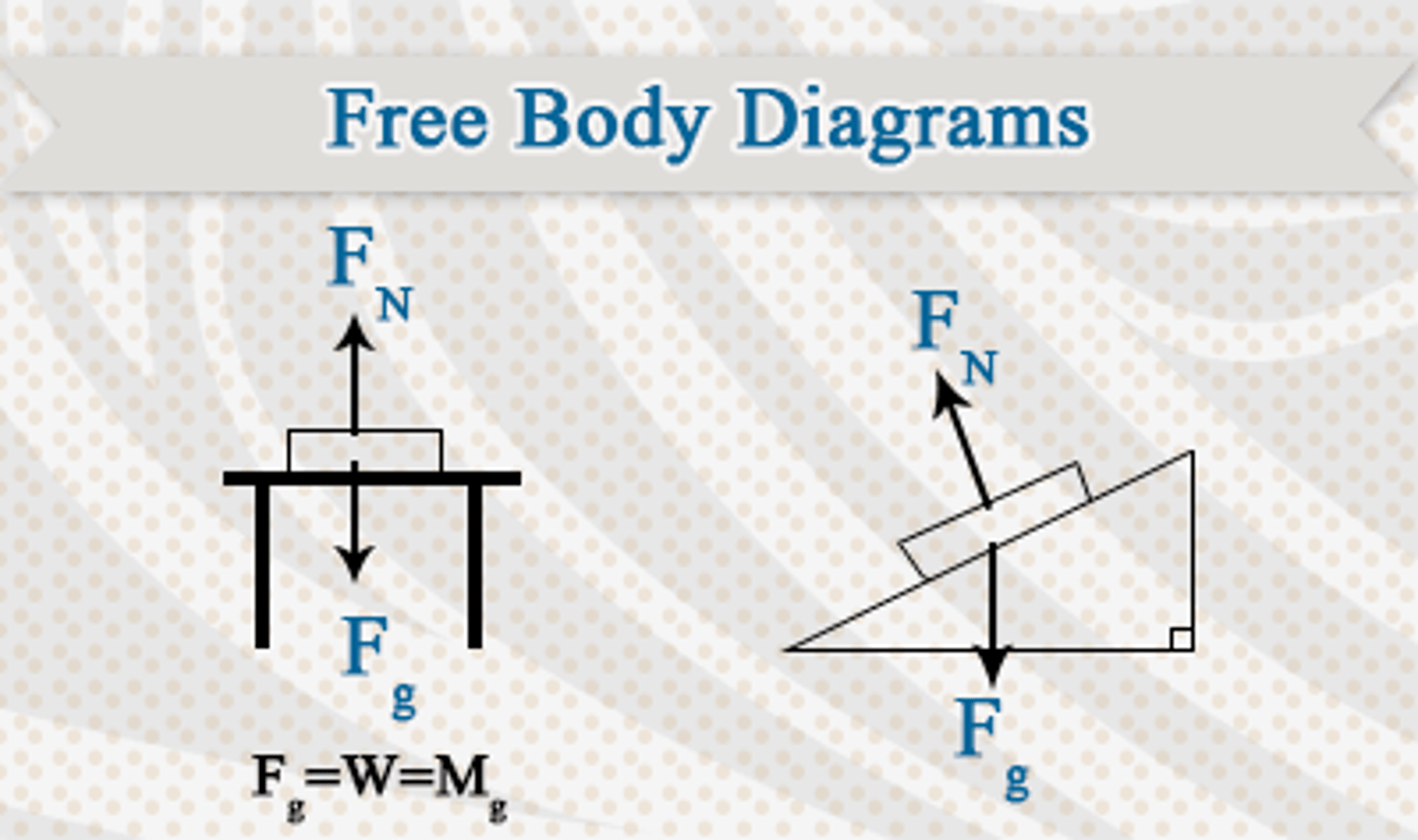Topic A flaschards
1/69
There's no tags or description
Looks like no tags are added yet.
Name | Mastery | Learn | Test | Matching | Spaced |
|---|
No study sessions yet.
70 Terms

velocity time graph
(A.1 Kinematics)
gradient= acceleration
y-intercept= initial velocity
area=displacement.
Straight (diagonal) line represents uniform acceleration
A curved line represents non-uniform acceleration
A Horizontal line represents motion with constant velocity
displacement time graph
(A.1 Kinematics)
Slope= velocity
y-intercept=initial displacement
A straight (diagonal) line represents a constant velocity
A curved line represents an acceleration
A Horizontal line represents a state of rest
The area under the curve is meaningless
acceleration time graph
(A.1 Kinematics)
Slope is meaningless
y-intercept= initial acceleration
Area = change in velocity
A straight line indicates uniform acceleration
A zero slope (horizontal line) represents an object undergoing constant acceleration
How do you find instantaneous speed and velocity of an object?
(A.1 Kinematics)
To find the instantaneous velocity on a displacement-time graph:
- Draw a tangent at the required time
- Calculate the gradient of that tangent
Projectile motion
(A.1 Kinematics)
- Divide SUVAT into two components: Horizontal and vertical
- The acceleration due to gravity is constant and downward throughout the motion
- The horizontal velocity, is constant and a=0 (if no fluid resistance).
- The vertical velocity, changes in magnitude and direction throughout the motion
Time of flight (projectile motion)
(A.1 Kinematics)
u=usin0, v= 0, a=-9.81, t=?
Maximum height attained
(A.1 Kinematics)
u=usin0, v= 0, a=-9.81,s= ?
Range (projectile motion)
(A.1 Kinematics)
u=ucos0, t=(2usin0)/g, a =0, s= ?
Terminal velocity
(A.1 Kinematics)
acceleration=zero
constant velocity
Forces are balanced: Fresistive=Fmg
Displacement=
(A.1 Kinematics)
velocity x time
Motion of a bouncing ball
(A.1 Kinematics)
- acceleration is constant
- between highest and lowest points velocity changes instantaneously from negative to positive
- max points: max displacement
-min points: min displacement
Factors that decrease in fluid resistance in projectile motion
(A.1 Kinematics)
- Time of flight
- Horizontal velocity
- Range
- Max height
Newton's 1st law
(A.2: Forces and Momentum)
A body will remain at rest or move with constant velocity unless acted on by a resultant force
Newtons 2nd Law
(A.2: Forces and Momentum)
F=ma
The resultant force on an object is directly proportional to its acceleration
Newtons 3rd law
(A.2: Forces and Momentum)
Every action has an equal and opposite reaction
A Newton's third law force pair must be:
- Same type of force
- Same magnitude
- Opposite in direction
- On different objects
Hooke's Law
(A.2: Forces and Momentum)
The extension of the material is directly proportional to the applied force.
Conservation of linear momentum
(A.2: Forces and Momentum)
The total linear momentum before a collision equals the total linear momentum after a collision unless a resultant external force acts on the system.
Elastic collisions
(A.2: Forces and Momentum)
- kinetic energy is conserved
- Objects colliding do not stick together and move in opposite directions after collision
Inelastic collisions
(A.2: Forces and Momentum)
- Kinetic energy is not conserved
- Objects colliding stick together and move in together after collision
Two-dimensional collisions and explosions
(A.2: Forces and Momentum)
Done by resolving vectors: splitting into horizontal and vertical components.
- X direction: cos0
- y Direction: sin0

Uniform circular motion (vertical circle)
(A.2: Forces and Momentum)
Centripetal force + gravitational force
- Maximum force at bottom
- Minimum force at top
conservation of momentum along the x direction
(A.2: Forces and Momentum)
mu + 0 = m1v1cos01 + m2v2cos01
conservation of momentum along the y direction
(A.2: Forces and Momentum)
0+0 = m1v1sin01 - m2v2sin02
Forces on object down a slope
(A.2 Forces and momentum)
Gravitational force: Fg= mg
Parallel to slope: Fg= mgsin(θ)
Perpendicular (Normal force): F= mgcos(θ)
Acceleration of object down the slope: a=gsin(θ) (assuming no friction)
Frictional force: Ff= μ x mgcos(θ)
Fnet= mgsin(θ) - μ x mgcos(θ)
a=g(sin(θ)−μcos(θ))
Forces on object up a slope
(A.2 Forces and momentum)
Gravitational force: Fg= mg
Parallel to slope: Fg= mgsin(θ)
Perpendicular (Normal force): F= mgcos(θ)
Frictional force: Ff= μ x mgcos(θ)
Fnet= Fapplied - Fg parallel + Ffriction
How do you see if forces are in equilibrium?
Fnet=0
Must form a closed triangle
From tip to tail
Force x displacement graph
(A.3: Work, Energy, Power)
Area= work done
Principle of conservation of energy
(A.3: Work, Energy, Power)
Energy is not created or destroyed, it only changes form.
Total energy of a closed system always stays the same
mechanical energy
(A.3: Work, Energy, Power)
sum of kinetic energy, gravitational potential energy and elastic potential energy
Under what circumstances will the mechanical energy of a system be conserved?
(A.3: Work, Energy, Power)
No frictional forces
Distance vs. Displacement
(A.1 Kinematics)
Distance: total path traveled (scalar).
Displacement: straight-line change in position (vector).
average velocity
(A.1 Kinematics)
total displacement divided by the total time taken
Forces
(A.2: Forces and Momentum)
interactions between bodies that can cause acceleration
Free body diagrams
(A.2: Forces and Momentum)
a diagram showing all the forces acting on an object
You can analyze the resultant (net) force by summing vectors to apply Newton's second law.

Normal force
(A.2: Forces and Momentum)
Force exerted by a surface or contact point
Acts perpendicular to surface
Prevents objects from falling into surface
Rest: N=mg
Pushing down= N=mg + Fdown
frictional force
(A.2: Forces and Momentum)
acts parallel to the surface and opposes motion or attempted motion between surfaces.
Opposes motion in any direction: right, left, up, or down
if there is an angle involved, it is equal to:
F=W x sin (0).
What's the difference between static and dynamic friction?
(A.2: Forces and Momentum)
Static friction prevents motion up to a maximum limit, while dynamic friction acts when the object is already moving.
Impulse
(A.2: Forces and Momentum)
change in momentum resulting from a force acting over a time interval.
What happens in an explosion in terms of momentum?
(A.2: Forces and Momentum)
The total momentum before explosion is zero, so after the explosion, fragments move in opposite directions to conserve momentum.
What causes circular motion?
(A.2: Forces and Momentum)
A centripetal force that acts towards the center of the circle.
Work
(A.3: Work, Energy, Power)
transfer of energy due to a force acting over a displacement.
What does it mean if mechanical energy is conserved?
(A.3: Work, Energy, Power)
No energy is lost to heat or other forms, so energy is just changing between kinetic, potential, or elastic.
Power
(A.3: Work, Energy, Power)
The rate of work done (or the rate at which energy is transferred).
Sankey diagram
(A.3: Work, Energy, Power)
A scale diagram used to represent the total input, the useful output and the wasted output energies within a system.
Rigid body assumption
(A.4: Rotational Motion)
- An object that doesn't deform under force
- All points in the body maintain fixed positions to each other
- Rotational and translational motion can be analyzed separately
Moment of inertia
(A.4: Rotational Motion)
How difficult it is to make a body accelerate
measure of an object's resistance to changes in its rotational motion
The farther the mass is from the axis, the larger the moment of inertia
The larger, the harder as there is less acceleration
Hollow objects: greater moment of inertia
Torque
(A.4: Rotational Motion)
a force that causes rotation
measure of how much a force acting on an object causes that object to rotate
Angular momentum
(A.4: Rotational Motion)
rotational momentum of a spinning or orbiting object
principle of conservation of angular momentum
(A.4: Rotational Motion)
The angular momentum of a system remains constant if no external torques act on it.
In rotational motion, gravitational potential energy gets transferred into...
(A.4: Rotational Motion)
Linear Ek, and Rotational Ek.
Torque against time graph
(A.4: Rotational Motion)
Area= Angular impulse
Density
Another word for material
What does it mean when a system is in equilibrium?
(A.4 Rotational motion)
τclockwise=τcounter-clockwise
∑τ=0
Newton's second law for rotation
(A.4: Rotational Motion)
the sum of all torques acting on a rotating object is equal to the product of the object's moment of inertia and its angular acceleration
What causes a change in angular momentum?
(A.4: Rotational Motion)
A resultant torque over time, called angular impulse
If torque depends on the angle of the force, no constant angular acceleration, can't use analogous SUVAT equations
τ=F⋅r⋅sin(θ)
When is angular momentum conserved?
(A.4: Rotational Motion)
When there is no external torque acting on the body.
What is an inertial reference frame?
(A.5: Relativity)
A non-accelerating frame where Newton's laws hold true.
What are the two postulates of special relativity?
(A.5: Relativity)
- The laws of physics are the same in all inertial frames.
- The speed of light in a vacuum is constant in all inertial reference frames.
Lorentz factor
(A.5: Relativity)
A way of transforming and expressing velocities in speed of light
Proper time (t0)
(A.5: Relativity)
Time measured by an observer at rest relative to the event.
How do you move forward in time relative to someone on Earth?
(A.5: Relativity)
Moving super fast relative to them for a long time.
proper length (Lo)
(A.5: Relativity)
Length measured in the rest frame of the object.
When does the length of objects appear to shrink relative to someone?
(A.5: Relativity)
The length of very fast moving objects
What does the relativity of simultaneity mean?
(A.5: Relativity)
Events that are simultaneous in one frame may not be simultaneous in another.
What do space-time diagrams show?
(A.5: Relativity)
The motion of particles over time, with time labeled as ct and distance as t.
What does the angle θ on a space-time diagram represent?
(A.5: Relativity)
The particle's speed
Multiple frames of reference in space-time diagrams
(A.5: Relativity)
S: Read directly from axes
S': Draw lines parallel to ct' and x' axes
What experiment supports time dilation and length contraction?
(A.5: Relativity)
Muon decay experiments—muons reach Earth's surface because time dilates in their frame.
Space time intervals
(A.5: Relativity)
- Invariant: They are the same from one reference frame to another
- Used to measure ho far apart two event are in spacetime
Invariant quantities
(A.5: Relativity)
- Proper time interval (t0)
- Proper length (L0)
- Space time interval (s)